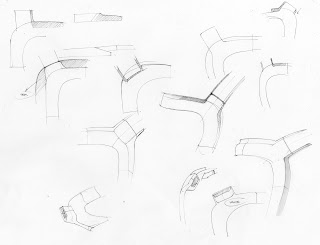Basic Mock-up Test for option 1: Quarter Turn Lock
Tuesday 30 August 2011
Development Ideation
Following on from the formative presentation feedback received, further development in surfacing of the strap connection points and mechanical aspects of the breathing component is needed.
 |
| Exploration of quater-turn locking mechanism - please view above video for further technical understanding. |
Monday 29 August 2011
Tuesday 16 August 2011
First Stage Foam Modeling
This process involves laminating thin sections of foam in two parts across the face to form the organic shape of the seal and offset for the frame. Here I was able build up to the correct thickness for the frame and develop the surfaces further.
Development Overlays (Front)
Basic overlay renders - provide an early indication of visual weight, fluency etc. from directly in front of the patient.
Creating a recessed visor as a facade may reduce some of the visual weight in the frame by simply overlapping it. Similar to performance snow goggles where a durable and often thicker frame is required for support and stability, however the visor overlaps a certain amount of the frame visually - reducing the thickness and weight of the goggle.
Circuit Orientation
Small adjustments in the positioning of the breathing attachment have proven to be quite significant in terms of the overall visual stature of the mask when considering balance and integration/addition.
Feedback from peers has correlated in regards to aesthetic weight and layout - Based on these profiles, further visual exploration will take place with specific interest in developing layout 1 (left) due to its less invasive placement, and more integrated feel.
Strap Details and Surfacing
Exploring the possibility of using the frame to strap intersection as a point of detailing. This is an attempt to create more harmony between the features of the mask that are most often poorly linked. Ideally the surfaces of the mask frame may read in such a way which creates aesthetic interest and could potentially lead to a smoother or more refined transition between the frame and strap.
Wednesday 10 August 2011
Tuesday 2 August 2011
Monday 1 August 2011
Subscribe to:
Posts (Atom)




































